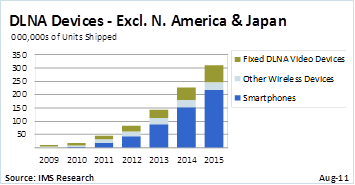Android Phones Will Dominate iPads As Home Media Hub, Analysts Predict
Android smartphones will quickly dominate as home media hubs, beating out Apple’s AirPlay, one market research firm predicts.
Within a few years most media hubs in the living room won’t be set-top boxes or DVRs, but Android smartphones, according to a newly-published study, “Video Content Distribution in the Smart Home,” by IMS Research.
These Android phones will send media to TVs and game consoles, just like Apple’s Airplay sends video to an Apple TV or other Airplay-enabled device.
The reason Android will dominate? Because Android manufacturers are quickly adding DLNA — The Digital Living Network Alliance’s open-standard media sharing protocol. It’s the fastest, cheapest way they can differentiate themselves from Apple’s iPhone, the report says.
“The consequence of Android smartphone manufacturers’ decision to include DLNA video servers in their handsets is very significant,” says Stephen Froehlich, a senior analyst at IMS Research. “Outside of the established North America and Japanese markets, this decision by smartphone manufacturers to push out DLNA video servers is very likely to create awareness of these functions.”
By 2015, 70 percent of DLNA devices shipped outside of Japan and North America will be wi-fi-enabled smartphones.
“The vast majority of those are expected to be Android-based handsets, as Apple is not expected to embrace open-standard media services on its iPhones, relying instead on AirPlay,” says the report.
DLNA video is already extremely widely adopted in Japan thanks to its inclusion in the country’s ARIB TV broadcast standards. In North America, lots of service providers are using DLNA to create open-standard multi-room DVR systems.
According to IMS, the trend will be most prevalent overseas.
“We also expect to see a new culture of video portability emerge from that awareness,” says Froehlich. “In these regions, the smartphone essentially becomes a personal ID key that unlocks a consumer’s access to his or her content library and then serves it to any DLNA video client in a home. This culture of media portability may lead to more aggressive cord-cutting in these regions than is anticipated in North America and Japan.”



